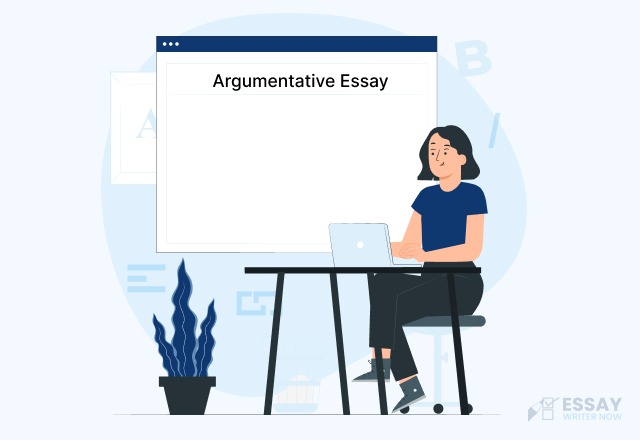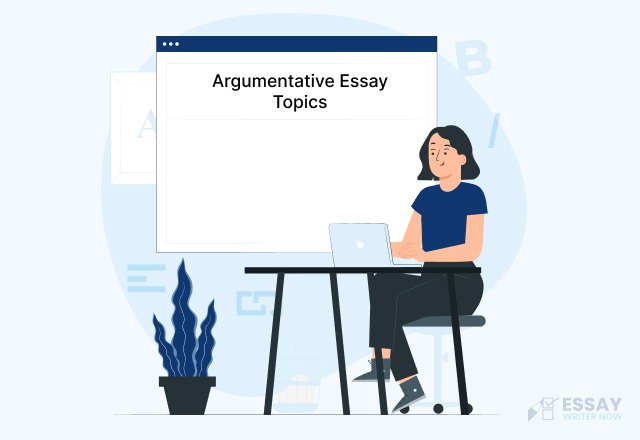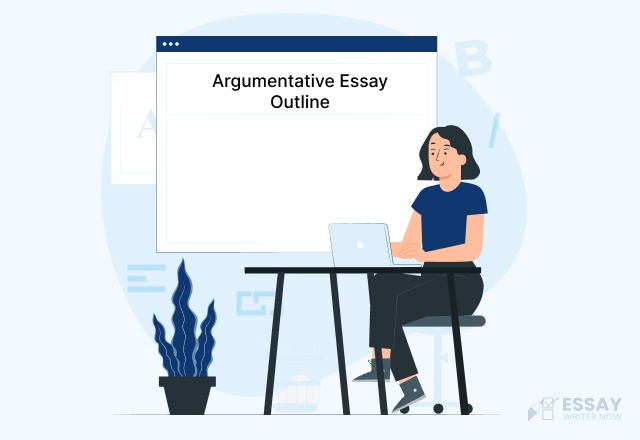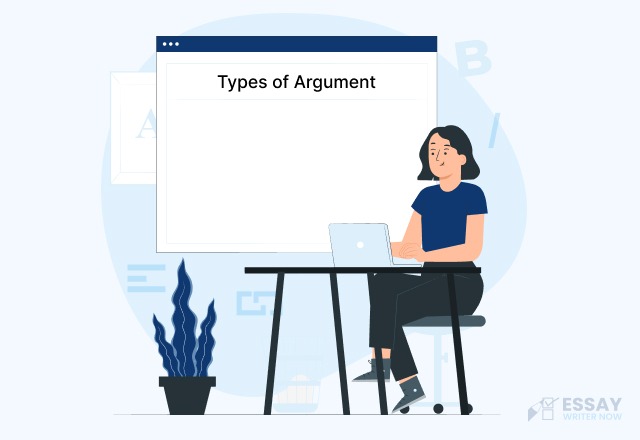What is an Argumentative Essay?
An argumentative essay is a genre of writing that aims to persuade the reader to accept a particular viewpoint or take a specific action. Unlike persuasive essays, which often rely on emotional appeals, argumentative essays prioritize factual evidence and logical reasoning to support their claims. This type of essay requires the writer to take a clear stance on an issue and provide compelling arguments backed by empirical data and credible sources.
Argumentative essays distinguish themselves from other types of essays, such as expository essays, by presenting a definitive position rather than merely exploring various perspectives without taking a stance. They are structured to present a coherent argument that convinces the reader of the validity of the writer's viewpoint through rigorous analysis and systematic presentation of evidence.
Key Characteristics of Argumentative Essays

Evidence-Based Argumentation
Central to an argumentative essay is the use of factual evidence to substantiate claims. This evidence can include statistics, research findings, expert opinions, and logical reasoning based on established principles.
Example:
| "Recent studies from NASA and the IPCC report indicate a significant rise in global temperatures over the past century, with 97% of climate scientists concurring that human activities, particularly greenhouse gas emissions, are the primary drivers." |
Clear Thesis Statement
A strong argumentative essay begins with a clear and concise thesis statement that articulates the writer's position on the issue. This thesis serves as the guiding principle throughout the essay, directing the focus of each paragraph and shaping the overall argument.
Example:
| "This essay argues that immediate global action is necessary to mitigate the catastrophic effects of climate change, including rising sea levels and extreme weather events." |
Addressing Counter Arguments
Effective argumentative essays anticipate and address opposing viewpoints. By acknowledging and refuting counter arguments, the essay demonstrates thorough understanding of the topic and strengthens its own position.
Example:
| "While some skeptics argue that climate change is a natural cycle, the overwhelming consensus among climate experts supports the anthropogenic origins of current climate trends. Natural variability alone cannot explain the rapid changes observed in recent decades." |
Logical Structure
Argumentative essays typically follow a structured essay format that includes an introduction, body paragraphs, and a conclusion. Each section is strategically crafted to build upon the previous one, leading the reader through a logical progression of ideas.
Example:
| “The essay follows a structured format with an introduction that introduces the thesis, body paragraphs that present evidence such as scientific data and expert opinions, and a conclusion that synthesizes key points and reinforces the urgency of addressing climate change through global cooperation.” |
Critical Analysis
Beyond presenting evidence, argumentative essays involve critical analysis of the evidence presented. This analysis helps clarify the significance of the evidence in relation to the thesis and reinforces the credibility of the argument.
Example:
| "Analyzing climate models and historical data reveals a clear correlation between increased CO2 emissions and global temperature rise. This critical analysis underscores the urgency of reducing carbon emissions to mitigate future climate impacts." |
Persuasive Language and Tone
While argumentative essays emphasize factual evidence, they also require careful attention to language and tone. Writers must maintain a persuasive tone that is respectful and professional, even when challenging opposing viewpoints.
Example:
| "While acknowledging the complexities of international climate policy, it is imperative that world leaders adopt decisive measures to curb emissions. The use of assertive yet respectful language encourages policymakers to prioritize environmental sustainability." |
Conclusion with Impact
The conclusion of an argumentative essay restates the thesis in light of the evidence presented and reinforces the essay's main arguments. It leaves a lasting impression by summarizing key points and emphasizing the broader implications of the argument.
Example:
| "In conclusion, the evidence presented highlights the pressing need for immediate action on climate change. By mitigating greenhouse gas emissions and embracing sustainable practices, humanity can safeguard the planet for future generations." |
5 Types of Argument Claims
When constructing an argumentative essay, understanding the different types of claims can help you frame your arguments more effectively. Here are the five main types of argument claims with explanations and examples for each:
Factual Claims
Factual claims assert that something is true or false based on evidence. These claims rely on empirical data, statistics, or observations to validate the argument.
Example:
| "Climate change is primarily caused by human activities such as industrial emissions and deforestation." |
Application:
Use factual claims when you have strong, verifiable data to support your argument. They are most effective when the facts are not widely disputed or when you have robust evidence to back them up.
Definition Claims
Definition claims argue about the definition or classification of a term or concept. These claims focus on establishing what something is or what it means.
Example:
| "Euthanasia should be classified as a form of medical treatment rather than assisted suicide." |
Application:
Use definition claims when there is ambiguity or disagreement about the meaning of a term. This type of claim is useful for setting the parameters of your argument and clarifying terms for the reader.
Value Claims
Value claims assert that something is good or bad, right or wrong, or better or worse compared to something else. These claims are subjective and based on moral, ethical, or aesthetic standards.
Example:
| "Capital punishment is morally wrong and should be abolished." |
Application:
Use value claims when you are making an argument based on personal or societal values. Support these claims with evidence and reasoning that appeal to the reader’s sense of ethics or standards.
Cause and Effect Claims
Cause and effect claims argue that one event or situation causes another. These claims establish a causal relationship between two or more elements.
Example:
| "The rise in global temperatures is causing more frequent and severe natural disasters." |
Application:
Use cause and effect claims when you need to show how one event leads to another. Provide clear evidence of the connection between the cause and the effect, and address potential counterarguments that might suggest alternative causes.
Policy Claims
Policy claims advocate for a specific course of action or change in policy. These claims argue that something should or should not be done.
Example:
| "The government should implement universal health care to ensure that all citizens have access to medical services." |
Application:
Use policy claims when you are arguing for or against a specific action or change. Support your claim with evidence showing why the policy is necessary and how it will lead to positive outcomes. Address potential objections to the proposed policy.
Practical Applications in Argumentative Essays
When writing an essay, you can use these different types of claims to structure your arguments effectively. Here’s an outline incorporating each type of claim:
Introduction: Body Paragraph 1: Factual Claim Example: "Data from the National Oceanic and Atmospheric Administration (NOAA) confirms that global temperatures have risen by 1.5 degrees Celsius since the pre-industrial era, primarily due to human activities." Body Paragraph 2: Definition Claim Example: "Climate change should be defined as long-term changes in temperature and weather patterns, primarily driven by human activities such as burning fossil fuels and deforestation." Body Paragraph 3: Value Claim Example: "Protecting the environment is a moral imperative because it ensures a livable planet for future generations." Body Paragraph 4: Cause and Effect Claim Example: "The increase in carbon emissions is directly causing more severe and frequent weather events, such as hurricanes and wildfires, which devastate communities." Body Paragraph 5: Policy Claim Example: "To combat climate change effectively, governments should implement strict regulations on carbon emissions and invest in renewable energy sources." Conclusion: |
By understanding and applying these five types of claims, you can create a well-rounded and persuasive argumentative essay that addresses different aspects of the issue comprehensively.
Basic Argumentative Essay Structure
Here is a basic structure you can follow to start your essay:
Introduction
Your essay’s introduction is crucial for your argumentative essay as it sets the tone and establishes the context for your argument. Here’s how to effectively structure it:
- Hook: Begin with an attention-grabbing hook statement that intrigues the reader and introduces the topic. This could be a startling statistic, a relevant quote, or a thought-provoking question.
Example:
| "Did you know that over 1.3 billion tons of food are wasted globally each year, while millions go hungry?" |
- Background Information: Provide brief background information on the topic to contextualize your argument. This helps readers understand the significance of the issue and why it matters.
Example:
| "Food waste has become a pressing issue worldwide, exacerbating hunger and environmental degradation." |
- Thesis Statement: Clearly state your main argument or position on the topic. Your thesis should be specific, debatable, and supported by evidence that you will present in the body paragraphs.
Example:
| "This essay argues that implementing stricter regulations on food distribution and consumer behavior is essential to reducing food waste and alleviating global hunger." |
- Overview of Arguments: Create a brief essay outline that contains main points or arguments that you will discuss in the body paragraphs. This gives the reader a roadmap of what to expect and how your argument will unfold.
Example:
| "First, I will examine the scale of food waste and its impact on food security. Next, I will discuss current regulatory measures and their effectiveness. Finally, I will propose specific policy recommendations to address this issue." |
Body Paragraphs
The body paragraphs form the core of your argumentative essay, where you structure your sentences to present evidence, analyze data, and refute counterarguments. Here’s how to structure each body paragraph effectively:
- Topic Sentence: Start each paragraph with a topic sentence that introduces the main point of the paragraph and relates it back to your thesis.
Example:
| "One of the primary reasons for high levels of food waste is inefficient distribution systems." |
- Evidence and Analysis: Provide specific evidence to support your argument, such as statistics, research findings, or expert opinions. Analyze this evidence to explain how it supports your thesis and contributes to your overall argument.
Example:
| "According to a report by the Food and Agriculture Organization, up to 30% of food produced worldwide is lost or wasted annually due to logistical inefficiencies." |
- Counter Argument and Refutation: Acknowledge potential counterarguments or opposing viewpoints. Refute these arguments by presenting evidence or logical reasoning that undermines their validity.
Example:
| "While some argue that consumer behavior is the primary cause of food waste, studies show that systemic issues in supply chains contribute significantly more to overall waste." |
- Transition: Use transitional words or phrases to smoothly connect each paragraph to the next and maintain coherence in your argument.
Example:
| "Furthermore, addressing these logistical challenges requires coordinated efforts from both governmental policies and private sector initiatives." |
Conclusion
The conclusion of your argumentative essay should effectively wrap up your argument and leave a lasting impression on the reader. Here’s how to structure your conclusion:
- Restate the Thesis: Begin by restating your thesis statement, emphasizing how your arguments have supported your position throughout the essay.
Example:
| "In conclusion, stricter regulations on food distribution and consumer behavior are necessary steps to mitigate food waste and ensure global food security." |
- Summarize Key Points: Provide a brief summary of the main arguments presented in the body paragraphs. Reinforce the significance of each point in relation to your thesis.
Example:
| "Throughout this essay, we have explored the scale of food waste, evaluated existing regulatory measures, and proposed actionable solutions to tackle this pressing issue." |
- Final Thought or Call to Action: End with a thought-provoking statement, a call to action, or a suggestion for further research. Encourage readers to consider the implications of your argument beyond the scope of your essay.
Example:
| "As global citizens, we have a collective responsibility to enact meaningful change in how we produce, distribute, and consume food. By implementing these strategies, we can move closer to a more sustainable and equitable future." |
Sample Outline for an Argumentative Essay on Food Waste
I. Introduction Hook: Startling statistics on global food waste. II. Body Paragraphs B. Regulatory Measures and Effectiveness C. Policy Recommendations III. Conclusion Restate Thesis: Reinforcement of the need for stricter regulations on food waste. |
Argumentative Essay Structures
You can write your argumentative essay in three prominent structures, which are:
Aristotelian (Classic)
The Aristotelian structure, known for its straightforward approach, is well-suited for presenting clear arguments and rebuttals. Here’s an expanded look at each step with examples:
Introduction of the Problem
Begin by clearly defining the issue or problem you are addressing. This sets the stage for your argument and establishes its relevance.
Example:
| "The rise in global temperatures due to human activities has sparked intense debate regarding the urgency of climate change mitigation." |
Explanation of Your Perspective
Present your thesis or claim along with the main points that support it. This section should outline your stance and the reasons behind it.
Example:
| "I argue that implementing stricter regulations on carbon emissions is crucial to mitigating the adverse effects of climate change." |
Explanation of Opponent’s Perspective and Refutation:
Acknowledge opposing viewpoints and systematically refute them using evidence and logical reasoning.
Example:
| "Critics of stringent carbon regulations argue that they could stifle economic growth. However, studies have shown that sustainable practices can lead to long-term economic benefits." |
Presentation of Evidence
Support your thesis with concrete evidence, such as statistics, studies, or expert opinions. This reinforces the validity of your argument.
Example:
| "Research by the IPCC demonstrates a direct correlation between human-induced carbon emissions and rising global temperatures, underscoring the need for immediate action." |
Conclusion of Your Argument
Summarize your main points and restate your thesis in light of the evidence presented. Emphasize why your perspective is valid and deserving of consideration.
Example:
| "In conclusion, while addressing climate change through stricter regulations poses challenges, the scientific consensus and long-term benefits justify proactive measures." |
Toulmin
The Toulmin method provides a structured framework for analyzing and presenting arguments. Here’s how each component can be applied with examples:
Claim
State your main argument or thesis clearly and effectively.
Example:
| "Universal healthcare coverage is a fundamental right that should be guaranteed by governments." |
Reasons
Provide evidence and reasons that support your claim, such as data or examples.
Example:
| "Countries with universal healthcare systems, like Canada and the UK, have lower mortality rates and better health outcomes compared to those without." |
Warrant
Explain the rationale or reasoning that connects your claim and evidence. This clarifies how your evidence supports your argument.
Example:
| "Access to affordable healthcare services promotes preventive care and reduces overall healthcare costs, benefiting society as a whole." |
Backing
Offer additional support or evidence to strengthen your warrant.
Example:
| "Research from the World Health Organization confirms that equitable access to healthcare services improves overall public health and reduces disparities." |
Qualifier
Acknowledge any limitations or conditions to your claim. This shows nuance and honesty in your argument.
Example:
| "While universal healthcare can enhance social welfare, its implementation requires sustainable funding and administrative oversight." |
Rebuttal
Address counterarguments or opposing viewpoints and explain why they are invalid or less convincing.
Example:
| "Critics argue that universal health care leads to increased taxes. However, studies show that overall healthcare expenditures decrease due to preventive care and reduced emergency room visits." |
Rogerian
The Rogerian method focuses on finding common ground and fostering understanding between conflicting viewpoints. Here’s how to structure your essay using this approach:
Introduction of the Problem
Introduce the issue or problem in a neutral and objective manner.
Example:
| "The debate over gun control in the United States remains contentious, with advocates on both sides passionately defending their positions." |
Acknowledgment of Opponent’s Perspective
Recognize the validity of the opposing viewpoint and its concerns.
Example:
| "Proponents of gun rights argue for the Second Amendment's protection of individual liberties and self-defense rights." |
Presentation of Your Perspective
Present your own stance or thesis, emphasizing areas of agreement or overlap with the opposing viewpoint.
Example:
| "While respecting individual rights, implementing stricter background checks and regulations can help reduce gun violence." |
Identification of Common Ground
Highlight shared goals or values between both perspectives.
Example:
| "Both proponents and opponents of gun control share a desire to enhance public safety and prevent mass shootings." |
Proposal of Compromise or Solution
Propose a solution or compromise that integrates elements from both viewpoints.
Example:
| "By promoting responsible gun ownership and implementing comprehensive background checks, we can balance individual rights with public safety concerns." |
How to Write a Good Thesis
A strong thesis statement is essential for guiding your argumentative essay. Here are key considerations and examples to help you craft an effective thesis:
Specific and Debatable Topic
Choose a focused topic that invites discussion and debate.
Example:
| "The use of social media among adolescents has a detrimental impact on mental health, evidenced by increased rates of anxiety and depression." |
Supported by Evidence
Ensure your thesis is backed by credible evidence and research.
Example:
| "Studies from the American Psychological Association demonstrate a significant correlation between excessive social media use and mental health disorders." |
Consider Your Audience
Tailor your thesis to address the concerns and biases of your audience.
Example:
| "While social media offers connectivity, its pervasive use among youth requires safeguards to mitigate negative psychological effects." |
Let’s wrap it up!
Writing an argumentative essay requires dedication, critical thinking, and attention to detail. You must use effective techniques and structure your essay well.By adhering to above tips, you can confidently present compelling arguments that resonate with your readers.
As you refine your argumentative writing skills, remember the importance of structure and clarity. Each element of your essay, from the introduction to the conclusion, should work cohesively to strengthen your argument. By incorporating the techniques and tips outlined in this guide, you'll be well-equipped to tackle any argumentative essay with confidence.






